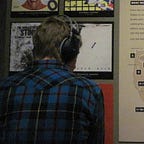Review: Crimes of the Future
David Cronenberg’s latest film — his first in eight years — opens on what could be mere decades from now. The locale is unknown, and the year is a mystery, but Crimes of the Future takes place in another cinematic dystopia. Nothing world-ending, mind you, just miserable. Microplastics in the water killed off wildlife. Furniture resembles sarcophaguses made of bone. However, the most notable fact of this world is that our bodies are evolving.
Saul Tenser (Viggo Mortensen) is one such man coping with this evolutionary burden. Tenser grows novel organs that his partner, Caprice (Léa Seydoux), surgically removes in front of audiences as performance art. Saul and Caprice are the toast of the town, though Saul is reclusive about his so-called gift. He evades an ever-invasive public, dressed as a Sith Lord, to hide from prying eyes. The National Organ Registry (Don McKellar and Kristen Stewart) would like to catalog Saul’s internal growths. The pair of bureaucrats pretend their interest is purely for science, but they have hidden motives.
For most of the first act, one wonders what Crimes of the Future is all about. The flowy dialogue indicates very little, but the actors swing for the fences with mannerisms. And the stilted dialogue is another hindrance. Mortenson and Seydoux manage to render each word vital, but other members of the ensemble struggle. Until the introduction of the New Vice Unit, scenes continue without much sense of purpose. Here is where Cronenberg lays out his thesis. Saul is just one of many with accelerated evolution syndrome. Despite his efforts to keep control over his body, others are using the adaptation to survive living in a toxic world.
Saul has made a career out of shock value but, presented with the opportunity to contribute something politically, he hesitates. The leader of the evolution group (Scott Speedman) needs Saul and Caprice to do a performance that will shock the public. People are too busy chasing pleasure; they need to be shocked into acting. Ironically, Crimes of the Future suffers from that which it rails against: apathy.
The unfeeling public that placidly records Saul on their ring cameras acts as an indictment of onlookers in today’s society. The invasive surgeries that Caprice performs on Saul aren’t bloodless, but with pain removed from the human condition, titillation has replaced it. People chase the high of sex in every bizarre mutilation. As Timlin (Stewart) whispers to Saul, “surgery is the new sex.” Ignoring atrocities in the pursuit of exhilaration, these artists play right into the hands of the New Vice Unit.
For all of the fire and fury Cronenberg wants to convey about the current times we live in, the film was written in 1999, and that feeling permeates through the film. The violence of Crimes of the Future is inert, lifeless. The word from Cannes was that walkouts would result from people disgusted by the proceedings. The most sickening part of the film isn’t the surgeries. It’s when Mortensen chokes down trays of baby food in his ergonomic chair, making the most horrific retching noises as he dines. At the matinee I attended, walkouts were merely from boredom. The metaphors for bodily control and the environment are easy to discern, yet Cronenberg traps all debate in semantics about aesthetics and meaning.
Debating over aesthetics is fine for the rebel art scene, yet it feels very self-serving for a small social circle. As caricature, Crimes of the Future succeeds in skewering the pretentious sycophants of the art-scene food chain, but, as a cautionary tale, this film misses the mark. The only real emotional heft comes just as the film ends. A black and white close-up of Mortensen’s face, deciding if he is writhing in pain or close to ecstasy, recalls The Passion of Joan of Arc. That one deeply affecting scene leaves one to ponder what else this project could have been.
Previous collaborations between Cronenberg and Mortensen (A History of Violence, Eastern Promises) served as a departure from the director’s previous highs, but he proved he didn’t need the gore as a crutch. Cronenberg returns again to the body horror on which he built his reputation, but in chasing that aesthetic again, it falls flatter. Much like the surgeries captured onscreen, Cronenberg is probing, but there’s nothing to feel.
